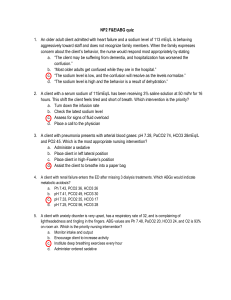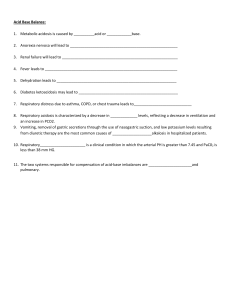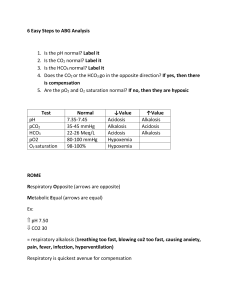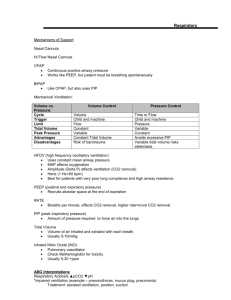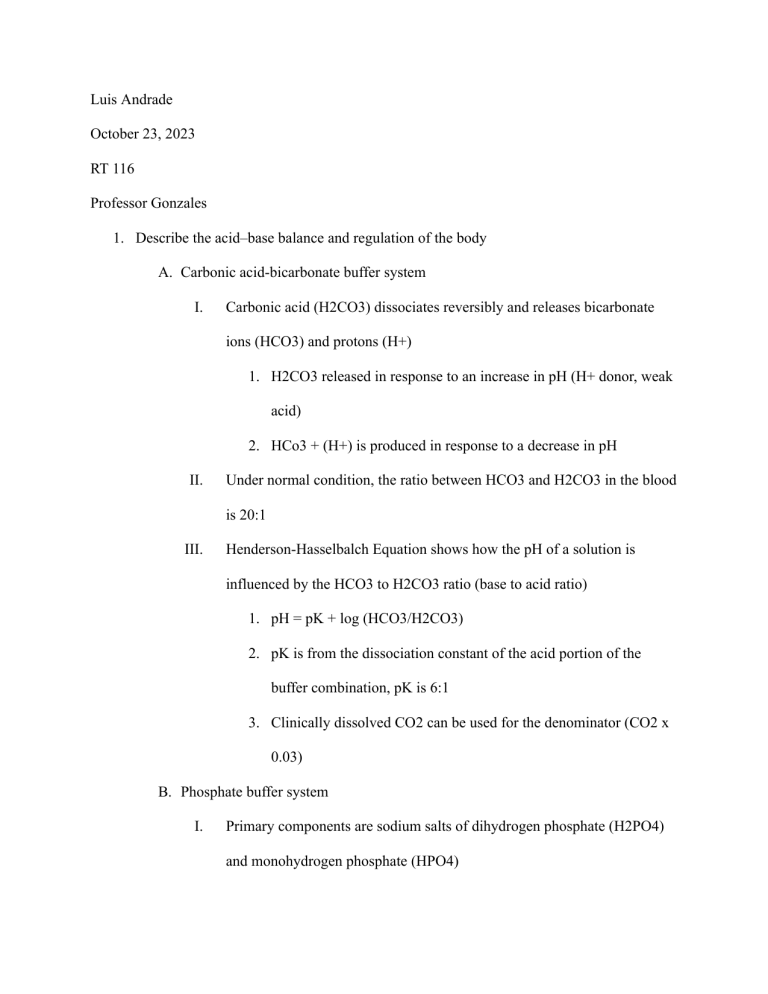
Luis Andrade October 23, 2023 RT 116 Professor Gonzales 1. Describe the acid–base balance and regulation of the body A. Carbonic acid-bicarbonate buffer system I. Carbonic acid (H2CO3) dissociates reversibly and releases bicarbonate ions (HCO3) and protons (H+) 1. H2CO3 released in response to an increase in pH (H+ donor, weak acid) 2. HCo3 + (H+) is produced in response to a decrease in pH II. Under normal condition, the ratio between HCO3 and H2CO3 in the blood is 20:1 III. Henderson-Hasselbalch Equation shows how the pH of a solution is influenced by the HCO3 to H2CO3 ratio (base to acid ratio) 1. pH = pK + log (HCO3/H2CO3) 2. pK is from the dissociation constant of the acid portion of the buffer combination, pK is 6:1 3. Clinically dissolved CO2 can be used for the denominator (CO2 x 0.03) B. Phosphate buffer system I. Primary components are sodium salts of dihydrogen phosphate (H2PO4) and monohydrogen phosphate (HPO4) II. When H+ ions are released by a strong acid then the system works to inactivate the acidic effects through these reactions. 1. HCl (strong acid) + Na2HPo4 (weak base) → NaH2PO4 (weak acid) + NaCl (salt) VI. Strong bases are converted to weak bases through this reaction 1. NaOH (strong base) + NaH2PO4 (weak acid) → Na2HPO4 (weak base) + H2O (water) C. Protein buffer system and acid base balance I. II. These buffers are found in the proteins within the plasma and cells. 75% of the buffering power of body fluids is found in the extracellular proteins. III. —COOH dissociates and liberate H+ in response to a rising pH 1. R—COOH → —COO + H+ IV. —NH2 group can bond with hydrogen ions to form —NH3 to function as a base and accept H+ 1. R—NH2 + (H+) → R—NH3 V. Because this reaction ties up free hydrogen ions, it prevents the solution from being too acidic. VI. A single protein molecule can function as either an acid or base relative to its pH environment. D. Respiratory system and acid base balance I. Takes longer to respond than the chemical buffer systems and has up to two times the buffering power of all the chemical buffer systems combined. II. Respiratory system eliminates CO2 from the body while also replenishing it with O2 III. The CO2 produced at the tissue cells enters the RBC and is converted to HCO3 ions IV. Under abnormal conditions, the respiratory system will quickly respond by either increasing or decreasing the respiratory rate and depth of breathing in order to compensate for acidosis or alkalosis. E. Renal system and acid base balance I. Can regulate alkaline substances in the blood and restore chemical buffers that are used in managing the H+ levels within the extracellular fluids. II. If the extracellular fluids become acidic then the renal system retains HCo3 and excretes H+ ions into the urine which increases the blood pH. III. When extracellular fluids become alkaline then the renal system retains H+ and excretes basic substances mostly (HCO3) into the urine which lowers the blood pH IV. Similarly, although the respiratory system can expel the volatile carbonic acid by eliminating CO2 V. It cannot expel other acids generated by cellular metabolism. Only the renal system can rid the body of acids (fixed acids) such as 1. Phosphoric acids 2. Uric acids 3. Lactic acids 4. Ketone acids 2. Identify the following acid– base disturbances on the PCO2 /HCO3 /pH nomogram: acute ventilatory failure with respiratory acidosis, acute ventilatory failure with partial renal compensation, and chronic ventilatory failure with complete renal compensation A. Effects on the disturbance of PCO2, HCO3, and pH I. Hypoventilation causes the PACO2 to increase which results in plasma PCO2, HCO3 and H2CO3 to all increase. This decreases the ratio and then pH decreases as a result II. Hyperventilation causes the PACO2 to decrease which results in plasma PCO2, HCO3 and H2CO3 to all decrease. This increases the ratio and pH will increase as a result B. Nomogram of PCO2 HCO3 and pH I. Acute ventilatory failure (respiratory acidosis) 1. As PACO2 levels progressively increase, the levels of blood PCO2, H2CO3, HCO3 will increase as well. 2. Acute changes in H2CO3 levels are much more significant than acute changes in HCO3 levels. 3. A ratio less than 20:1 will cause the blood pH to decrease. 4. pH and HCo3 changes were caused by the sudden increase in PCO2, the patient becomes hypercapnic and results in hypoventilation. 5. Nomogram reads 28 HCO3, PCO3 at 80 mm Hg, and pH at 7.18, acute ventilatory failure is confirmed 6. II. Acute ventilatory failure with partial renal compensation 1. Present when the reported pH and HCO3 2 both are above the normal red-colored PCO2 blood buffer bar (in the purple-colored area), but the pH is still less than normal. 2. III. Chronic ventilatory failure with complete renal compensation 1. Present when the HCO3 increases enough to cause the acidic pH to move back into the normal range (7.35 or higher), which, in this case, would be above 42 mEq/L 2. In short, it is defined as a >PaCo2 levels, > HCO3 levels elevated and a normal pH which means that this is their normal although the HCO3 and the PaCO2 is not within normal ranges. A balanced pH is always the goal for the body. 3. Identify common causes of acute ventilatory failure. A. 4. Identify the following acid– base disturbances on the PCO2 /HCO3 2/pH nomogram: acute alveolar hyperventilation (respiratory alkalosis), acute alveolar hyperventilation (with partial renal compensation), and chronic alveolar hyperventilation (with complete renal compensation) A. Acute alveolar hyperventilation (respiratory alkalosis) I. PACO2 will decrease and allow more CO2 molecules to leave the pulmonary blood. This causes a decrease in blood PCO2, H2CO3 and HCO3 levels. II. Acute changes in H2CO3 levels is really dangerous and will cause a significant increase in the HCO3 to H2CO3 ratio. This results in the pH to increase, becoming more alkaline. III. The resultant pH and HCO3 2 changes caused by an acute decrease in the PCO2 level can be easily identified by using the right side of the red-colored normal blood buffer bar located on the PCO2 /HCO3 2/pH nomogram IV. Acute alveolar hyperventilation is confirmed when the reported PCO2 , pH, and HCO3 2 values all intersect within the red-colored “Respiratory Alkalosis” bar V. B. Acute alveolar hyperventilation (with partial renal compensation I. Present when the reported pH and HCO3 2 both are below the normal red-colored PCO2 blood buffer bar (in the green-colored area), but the pH is still greater than normal. For example, when the PCO2 is 20 mm Hg at a time when the pH is 7.50 and the HCO3 2 is 15 mEq/L, alveolar hyperventilation with partial renal compensation is confirmed. II. C. Chronic alveolar hyperventilation (complete renal compensation) I. II. Also called compensated respiratory alkalosis Present when the HCO3 2 level decreases enough to return the alkalotic pH to normal (7.45 or lower), which, in this case, would be below 14 mEq/L. 5. Identify common causes of acute alveolar hyperventilation A. 6. Identify the following acid– base disturbances on the PCO2 /HCO3 2/pH nomogram: metabolic acidosis, including the anion gap; metabolic acidosis with partial respiratory compensation; metabolic acidosis with complete respiratory compensation; and combined metabolic and respiratory acidosis. A. Metabolic acidosis I. The presence of other acids not related to an increased PCO2 levels 1. Present when the PCo2 reading is within the normal range but not within the red-colored normal blood buffer line when compared to the reported HCo3 and pH levels. This is because the pH and HCO3 readings both lower than expected for a normal PCo2 level 2. The pH, HCo3 and PCo2 readings will all intersect within the purple-colored “Metabolic Acidosis” bar. 3. II. Anion Gap 1. Used to determine if a patient’s metabolic acidosis is caused by either the accumulation of fixed acids or an excessive loss of HCO3 2. According to the law of electroneutrality, the total number of plasma positively charged ions (cations) must equal the total number of plasma negatively charged ions (anions) in the body fluids. 3. The most common measured cations are sodium (Na+) ions. 4. The most commonly measured anions are chloride (Cl) and bicarbonate (HCO3) 5. Anion gap is the difference between Na ions and the sum of the HCo3 and Cl ions 6. The normal range of the anion gap is 9-14 mEq/L. B. Metabolic acidosis with partial respiratory compensation I. Present when the pH, HCo3 and PCo2 all intersect in the yellow colored area of the PCO/HCO3/pH nomogram then this indicates that metabolic acidosis with partial respiratory compensation is present. II. PaCO2 has decreased below the normal range but pH is still below normal. III. C. Metabolic acidosis with complete respiratory compensation I. Present when the PCo2 decreases enough to move the acidic pH back to the normal range II. pH in the normal range makes the ABG reading to be fully compensated D. Combined metabolic and respiratory acidosis I. When the pH, HCO3 2, and PCO2 readings all intersect in the orange-colored area of the PCO2 /HCO3 2/pH nomogram, both metabolic and respiratory acidosis are present. II. Occurs when PCO2 is elevated, HCO3 is decreased and pH is acidotic. 7. Identify common causes of metabolic acidosis A. 8. Identify the following acid– base disturbances on the PCO2 /HCO3 2/pH nomogram: metabolic alkalosis, metabolic alkalosis with partial respiratory compensation, metabolic alkalosis with complete respiratory compensation, and combined metabolic and respiratory alkalosis A. Metabolic alkalosis I. Is the presence of other bases, not related to a decreased PCO2 level or renal activity II. Is present when the pCO2 is within normal range but not within the red normal blood buffer line when compared to the reported pH HCO3 levels because of the elevated pH and HCO3 III. The pH, HCO3 2, and PCO2 readings will all intersect within the purple-colored “Metabolic Alkalosis” bar IV. B. Metabolic alkalosis with partial respiratory compensation I. For example, when the PCO2 is 60 mm Hg at a time when the pH is 7.50 and the HCO3 2 is 46 mEq/L, metabolic alkalosis with partial respiratory compensation is present II. PACO2 is above normal range as well as the pH. HCO3 is above normal ranges as well so since the HCO3 and pH are both alkalotic then this is a metabolic issue being compensated by the elevation of PCO2 III. C. Metabolic alkalosis with complete respiratory compensation I. Present when the PaCO2 increases enough to put the alkalotic pH back to the normal range. II. pH in the normal range means that the ABG is fully compensated (complete compensation) D. Combined metabolic and respiratory alkalosis I. When the pH HCo3 and PCO2 readings all intersect in the blue colored area of the PCO/HCO3/pH nomogram. II. PCO2 has to be alkalotic, HCO3 is alkalotic, and pH is alkalotic. III. 9. Identify common causes of metabolic alkalosis. A. 10. Describe base excess/deficit. A. Calculated through the PCO2/HCO3/pH monogram B. Base excess/deficit is described by the amount of base that is required to normalize the pH of the blood. C. Base excess/deficit can quantify the nonrespiratory acid-base imbalance. D. The base excess/deficit is reported in milliequivalents per liter (mEq/L) of base above or below the normal buffer base line of the PCO2 /HCO3 2/pH nomogram I. Examples: 1. pH 7.50, HCO 31 mEq/L and PCO2 40 mm Hg. There is an excess of 7 mEq/L 2. If pH is 7.25, HCO3 17 mEq/L, and PCO2 40 mm Hg. There is an excess of 7mEq/L
